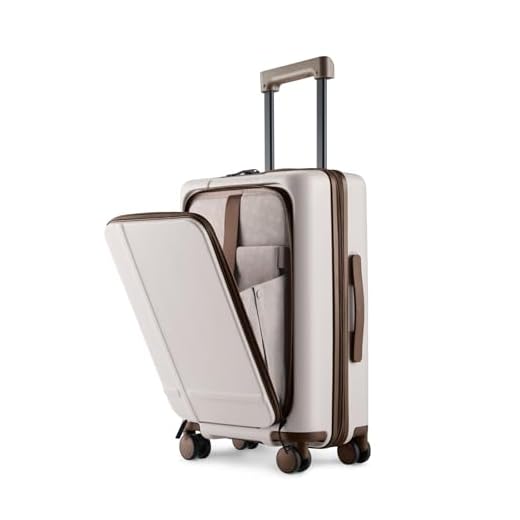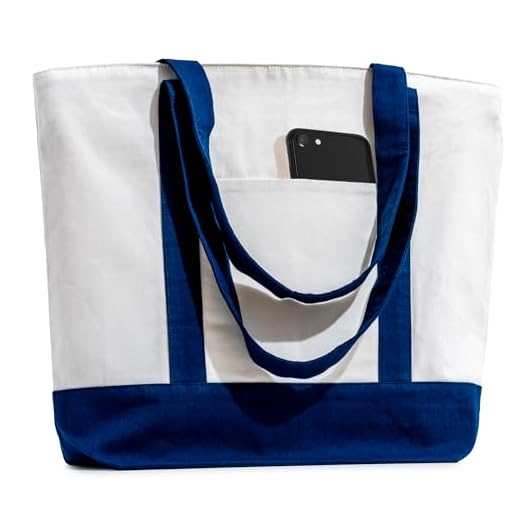






Opt for materials like organic cotton, hemp, or cork for your next travel bag. These options remain free from harmful additives and synthetic treatments, ensuring safety for both the user and the environment.
Look for brands that specifically advertise non-toxic manufacturing processes. Labels that state “chemical-free” or “eco-conscious” can guide you towards safer choices, while certifications such as GOTS (Global Organic Textile Standard) or OEKO-TEX can further validate eco-friendly claims.
Consider the durability of your travel gear. Bags made from recycled materials often showcase commitment to sustainability without compromising quality, while avoiding the use of harsh chemicals in production.
Research companies that prioritize transparency regarding their sourcing and production methods. Engaging with customer reviews and expert opinions can provide insights into safety and environmental impact, helping ensure your selections align with sustainable practices.
Non-Toxic Options for Travel Gear
Opt for travel bags made from organic cotton or hemp. These materials provide durability without harsh substances, ensuring a safer choice for the environment and health.
Consider products crafted from recycled materials, like PET from plastic bottles. This eco-friendly option minimizes chemical exposure while promoting sustainability.
Look for travel cases labeled as free from harmful substances. Certifications such as OEKO-TEX™ guarantee that the materials have been tested for safety and toxicity.
Explore brands that prioritize green manufacturing processes, using vegetable-based dyes and natural treatments. This approach reduces chemical usage in production.
Evaluate hard-shell alternatives made from polycarbonate. This lightweight, robust material typically contains fewer toxic additives compared to traditional plastics.
Choose items with minimal embellishments. Simple designs often use fewer chemicals in production and finishing processes, contributing to a safer product.
Materials Used in Chemical-Free Luggage
Opt for products crafted from organic cotton, hemp, or recycled polyester. These fabrics offer durability and resistance to wear while remaining free of harmful substances. Organic cotton is cultivated without synthetic pesticides, making it a safe choice for environmentally conscious consumers.
Natural Fibers
Hemp is another outstanding option for bags, known for its robustness and biodegradability. It requires minimal water and no chemicals during growth, contributing to a lower environmental footprint. Both hemp and organic cotton ensure comfort and safety for personal belongings.
Sustainable Alternatives
Recycled materials, such as rPET (recycled polyethylene terephthalate), derived from post-consumer plastic waste, serve as another viable alternative. This eco-friendly material emphasizes sustainability and significantly reduces environmental impact compared to traditional plastics.
For those seeking premium selections, investigate best luggage brands briggs and riley, known for their commitment to using eco-friendly materials in their product lines.
Incorporating sustainable materials into travel accessories not only reflects personal values but also promotes a healthier planet. Make informed choices for long-lasting, safe, and stylish options.
Identifying Eco-Friendly Brands and Manufacturers
Look for companies that prioritize sustainability and transparency in their production processes. Brands such as Patagonia and Osprey are known for their commitment to eco-friendly practices, using recycled materials and ethical labor standards.
Investigate the certifications held by manufacturers. Labels like Global Organic Textile Standard (GOTS) or OEKO-TEX signify adherence to strict environmental and safety regulations. These certifications ensure products are free from harmful substances.
Research specific materials utilized by brands. Eco-conscious companies often incorporate organic cotton, hemp, or recycled polyester, which are inherently less harmful to the environment compared to synthetic alternatives.
Examine customer reviews and ratings to gauge the reputation of a brand regarding environmental responsibility. Genuine feedback can highlight companies that prioritize minimal environmental impact.
Follow industry trends by subscribing to sustainability-focused publications or websites. This keeps you informed about new advancements and innovators dedicated to producing environmentally-friendly travel solutions.
Attend eco-friendly product expos or trade shows to discover emerging manufacturers committed to sustainability. Engaging directly with representatives allows for deeper insight into their environmental practices.
Benefits of Using Non-Toxic Luggage Options
Choosing bags free from harmful substances leads to significant health advantages. Many individuals experience allergies or sensitivities to synthetic materials often used in conventional travel gear. Opting for natural fabrics like organic cotton or hemp helps prevent skin irritations and respiratory issues.
Environmental Impact
Using eco-friendly travel gear significantly reduces waste and pollution. Sustainable materials decompose more easily, contributing less to landfill overflow. Additionally, the manufacturing processes for non-toxic items often employ lower levels of water and energy, minimizing ecological footprints.
Durability and Longevity
Items crafted from organic or recycled materials generally exhibit enhanced resilience. While mainstream options may sacrifice durability for cost savings, sustainable alternatives offer longevity, which translates to fewer replacements over time and thus less waste generation.
How to Evaluate Totes for Chemical Safety
Focus on labels. Check for certifications such as Oeko-Tex, GOTS, or Bluesign, which indicate that the product meets strict environmental and safety standards.
Assess Material Composition
Investigate the fabrics used. Natural fibers like organic cotton, linen, and hemp are often free from harmful substances. Synthetic materials like polyester or nylon may contain chemicals, so ensure they are treated with non-toxic processes.
- Look for bags made from recycled materials, which are less likely to contain harmful additives.
- Avoid items with coating treatments unless specified as eco-friendly.
Research Brands
Identify manufacturers committed to sustainable practices. Seek out brands known for transparency regarding material sourcing and production methods. Reviews and ratings on eco-conscious websites can provide insights into the safety of products.
- Look for companies that engage in third-party testing.
- Check if the brand is part of organizations that advocate for environmental responsibility.
Consider the lifecycle of the item. Opt for durable options that minimize waste and are designed to last, reducing the need for replacements and the associated chemical use in mass production. Choose items that are easy to clean and maintain, helping to prolong their usability.
Consumer Certifications for Chemical-Free Products
Seek certifications that confirm the absence of harmful substances in travel gear. Notable standards include OEKO-TEX, GOTS (Global Organic Textile Standard), and Greenguard Certified. These labels assure buyers that materials used have been tested for toxins and meet stringent health and environmental criteria.
Key Certifications
| Certification | Description |
|---|---|
| OEKO-TEX | Tests for harmful substances in textiles, ensuring safety for human use. |
| GOTS | Defines requirements for organic textiles and ensures ecological and social criteria are met. |
| Greenguard | Certifies products for low chemical emissions, promoting healthier indoor air quality. |
Research brands that proudly display these certifications on their products. This indicates a commitment to sustainability and health safety. For instance, explore premium umbrellas like the best mens luxury umbrella made with eco-conscious practices.
Verify claims by visiting manufacturer websites or looking for certification marks on product packaging. This additional layer of scrutiny will assure that your choices align with a chemical-free environment.
For those concerned about maintenance, ensure you know how to keep items in pristine condition. Resources are available for various materials. For example, learn how to clean cat pee out of leather to maintain quality and longevity.
Practical Tips for Maintaining Chemical-Free Luggage
Regularly inspect your travel gear for wear and tear. Look for frayed edges or broken zippers, which can indicate potential exposure to harmful substances. If repair is possible, consider fixing rather than replacing.
Cleaning and Care
Use natural cleaning solutions such as vinegar and baking soda to maintain your items. Avoid commercial cleaners that may contain harmful chemicals. After each use, wipe down surfaces to remove dirt and grime that could harbor toxins.
- For fabric items, consider hand washing with eco-friendly detergents.
- For hard-sided cases, a damp cloth with a mild solution works best.
Proper Storage
Store travel gear in a dry, well-ventilated area to prevent mildew and mold growth, which can lead to the release of harmful substances. Use breathable cotton or linen bags for protective storage.
- Avoid plastic covers that can trap moisture.
- Keep away from direct sunlight, as UV rays can degrade materials over time.
Label any repaired or modified components to track which parts may require future attention. This habit ensures long-term usability while maintaining safety standards.
FAQ:
What materials are used in luggage that is chemical-free?
Many manufacturers produce luggage using natural materials that do not contain harmful chemicals. This can include materials like organic cotton, hemp, and untreated leather. Additionally, some brands utilize recycled materials that are processed without toxic chemicals. When shopping for luggage, always check the labeling or product descriptions to ensure that the materials meet your standards for chemical safety.
Are there specific brands known for producing luggage without chemicals?
Yes, several brands focus on eco-friendly and chemical-free products. Brands such as Tom Bihn and Patagonia offer luggage made from materials free of harmful substances. Additionally, looking for companies that prioritize sustainable practices can lead you to more options that align with your preference for non-toxic luggage.
How can I verify that my luggage is free from chemicals?
To verify that luggage is free from chemicals, you can take a few steps: first, read the product descriptions carefully to look for mentions of chemical-free materials. Look for certifications such as OEKO-TEX or GOTS, which indicate that the materials meet specific safety standards. Another option is to contact the manufacturer directly and inquire about their materials and production processes. This way, you can be more confident in your purchase.







